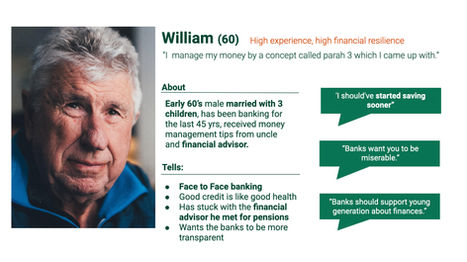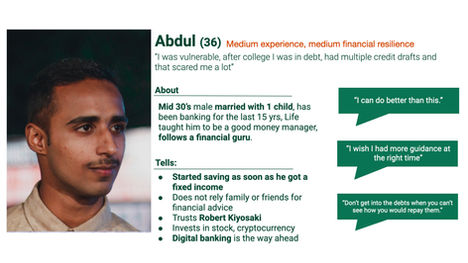
Our project in 60 seconds

The Context
what is vulnerability? The Financial Conduct Authority, conducted a research in defining when a person could be defined as vulnerable. They discovered that 50% of people in the uk shows characteristics of potential vulnerability. The categories are health, life event, capabilty and resilience. These 4 main categories are usually overlapping with each other. Since financial resilience can effect about 30% of the Uk, we decided to dig deeper into this.
This resilience needs to be built over time and it is the result of a plan. Here we draw a scheme with two examples.The first one in red, is a person that has no financial plan, so when a life event happens they have no resilience to recover from it so fall under the vulnerability limite. Whereas the green person which had a financial plan, the impact is diluted over the lifetime.
To summerise the ‘lack of resilience’ may lead people to become vulnerable in the future.


Research methodologies


Persona's made after interviews

Our Research Findings
As banking was new to us, We interviewed a vast demographic to truly understand finances, daily behaviour on spending and saving, financial education, history of interaction with the bank, and self-evaluation for own financial activity etc. Below are the 4 insights about young adults through research.

Environment produce/deteriorate vulnerability
People who we interviewed remarked that they "rarely talk about money", so, they need someone nudge and guide them to right way.
People perceive Bank as a trap, rather than a partner
Surprisingly, most of interviewee has no positive impression towards Bank. Some even said "don't trust bank". interaction with bank should be improved.
Perception is not consistent
with reality
What was interesting is that their self evaluation towards own money management is not correct in some ways. We think having right perception is the first step to have resilience.
They have a policy or rule for spending, but don't have it for saving.
Young people care about spending money, but almost nobody has any rule for saving money. They live for today and look at the future as a distant phenomenon. It's matter of priority, so raising saving priority is the key.

why young adults have a policy for spending but not for saving?
Bank plans are restrictive and boring.
Saving isn't part of their everyday life.
There is no support & emotional connection with savings.


Lysa's Character
-
You can choose the amount to save per trigger
-
Uniquely you can choose how want to save it. link your daily activities to a saving opportunity making it a part of your lifestyle.
-
And also you become part of by the Lysa community.
You can support your friends, share your saving plan, and motivate others to join THE NEW SAVING TREND.

A 2 minute introduction of Lysa


Lysa's Features
Lysa is a platform tailored for the Lloyds banking group customers. In order to maintain brand coherence, each tone of voice of brands is used as a theme for each bank within the LBG umbrella.
The platform has Community of savers who can inspire and motivate each other. Within the Lysa Community, Josh can also create new content in the form of saving plans.
Josh and his friends are a digital and social generation, who are highly influenced by the action of others. Eventually we will have plans branded by the influencers which will help to promote Lysa.
For a fee 3rd party collaborators can place their products on the platform and in return they can reach potential customer.
Products provided by Third party collaborators can be placed in two touchpoints: First, Josh can choose products from the list and set it as goals. Second, Josh get discounts as a reward when he reached the goal.



